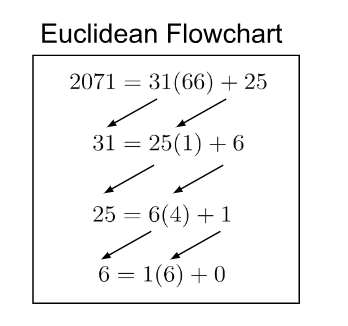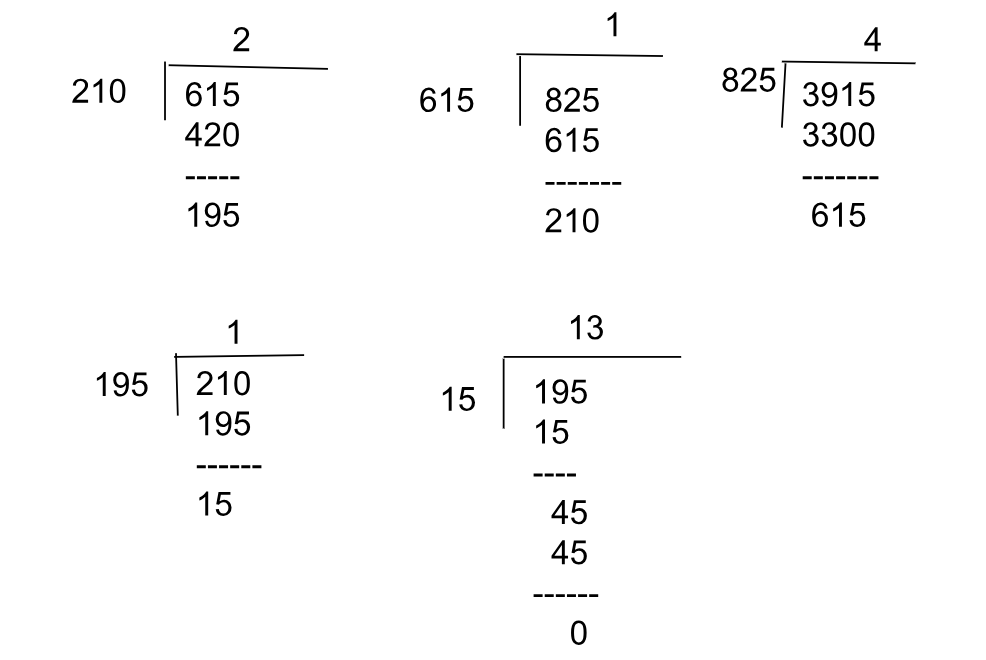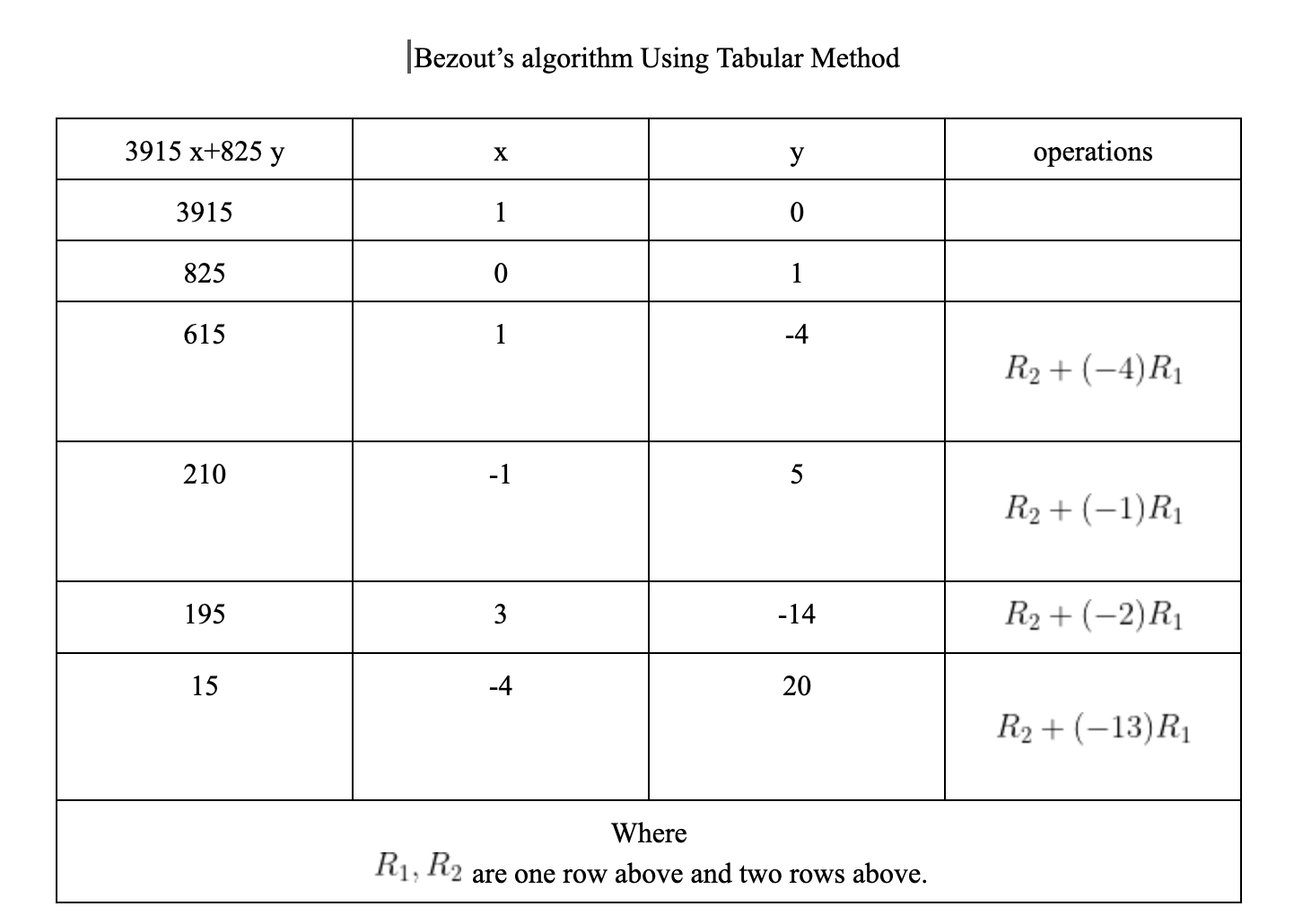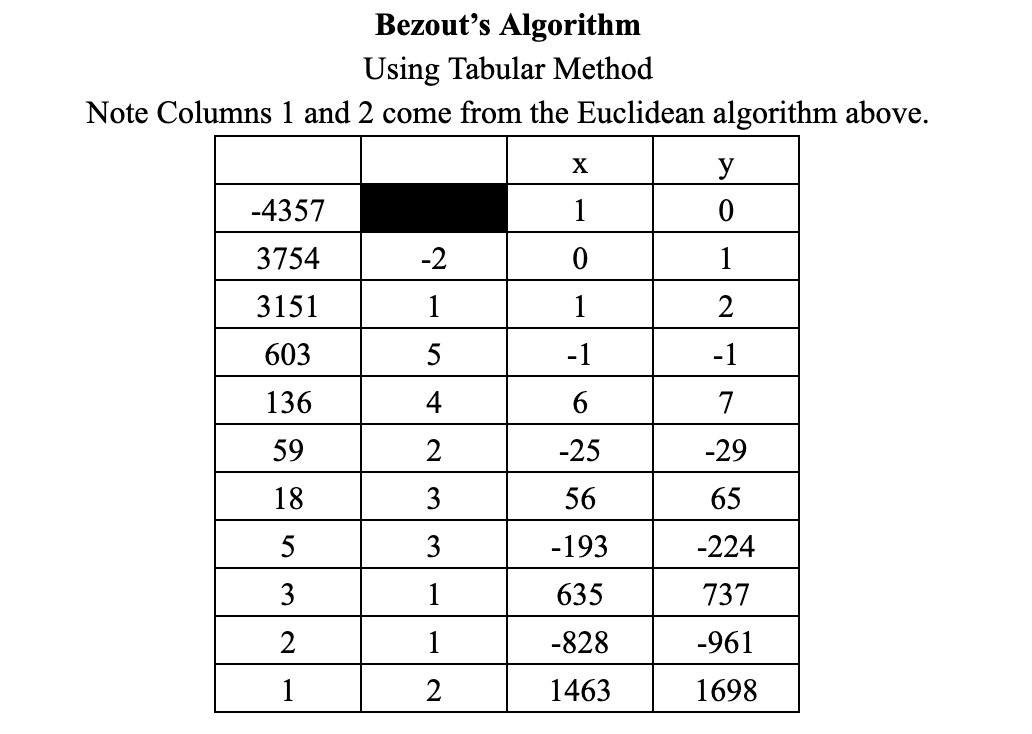1.2: Greatest common divisor and least common multiple
( \newcommand{\kernel}{\mathrm{null}\,}\)
Think out loud
We want to tile a 253 ft by 123 ft (a=253 and b=123, with a,b∈Z) floor with identical square tiles. What is the largest square tile we can use?
Definition: Greatest Common Divisor
Let a,b∈Z, where not both a,b is zero.
Then, we say that an integer d=gcd(a,b)∈Z+., greatest common divisor if it satisfies the following conditions:
-
d|a and d|b, Note: d must divide both numbers
2. If c∈Z, c|a and c|b then c≤d. Note: d is the greatest number divides both.
Thus, the greatest common divisor of two integers a and b, also known as GCD of a and b, is the greatest positive integer that divides both the integers a and b. This class will use the following notation: gcd(a,b).
Example 1.2.1:
What is the gcd of 15 and 20?
A process to find the solution:
List all positive divisors of 15 and 20.
The positive divisors of 15 are 1,3,5, and 15.
The positive divisors of 20 are 1,2,4,5,10, and 20.
The common positive divisors are 1,5.
As you can see from the list the gcd of 15 and 20 is 5. That is, the gcd(15,20)=5.
Example 1.2.2:
An elementary gym teacher has 3 grade 4 gym classes with 21,35 and 28 students in them. The teacher wants to order equipment that equal-sized groups can use in each class. What is the largest group size that will work for all 3 classes?
Solution:
You will need to find the GCD of all 3 classes.
Firstly, you will find the GCD of 21 and 35.
The positive divisors of 21 are 1,3,7, and 21.
The positive divisors of 35 are 1,5,7, and 35.
The GCD of 21 and 35 is 7.
Since 7∣28 you will now find the GCD of 7 and 28, which turns out to be 7.
Therefore the GCD of 21,35 and 28 is 7.
Thus, the largest number of students in a group for each class will be 7.
Properties:
Let a,b,c∈Z.
Then:
- gcd(a,a)=|a|,a≠0.
- gcd(a,b)=gcd(b,a).
- gcd(a,b,c)=gcd(gcd(a,b),c)=gcd(a,gcd(b,c)).
- gcd(a,0)=a.
- gcd(0,0) is undefined.
Now, let's explore an algorithm for determining the GCD. The Euclidean Algorithm, developed by the renowned Greek mathematician Euclid, is a highly effective method for computing the GCD of two integers.
If a,b∈Z∖{0}, then by using division algorithm iteratively, we obtain
a=bq0+r0b=r0q1+r1r0=r1q2+r2⋮rn−2=rn−1qn+rnrn=rnqn+1+0
Notice that, the last non-zero remainder is rn, such an rn exists, since |b|>|r0|>|r1|⋯>|rn|. The rn=gcd(a,b).
Find gcd(2420,230).
Note: Work from right to left to follow the steps shown in the image below.

Hence, gcd(2420,230)=10.
BEZOUT'S IDENTITY
For integers a and b, let d be the greatest common divisor, d = GCD (a, b). Then there exists integers x and y such that ax+by=d. Any integer that is of the form ax+by, is a multiple of d.
Note
This condition will be a necessary and sufficient case of d=1. We will prove this result in the section Relatively Prime numbers.
Write gcd as a linear combination. gcd(2071,31)=2071x+31y, with x,y∈Z.
Solution
Steps are listed (a,b,c,d) for ease of reference to Bezout’s algorithm
a) 2071=31(66)+25
b) 31=25(1)+6
c) 25=6(4)+1
d) 6=1(6)+0. The process stops when the remainder is zero. Thus, gcd=1.
Bezout’s Algorithm
-
25=2071+31(−66) from a) above.
-
6=31+25(−1) from b) above.
-
1=25+6(−4) from c) above.
1=25+6(−4) from 3) above.
=25+(31+25(−1))(−4)=25(5)+31(−4) using 2) above.
=(2071+31(−66))(5)+31(−4) using 1) above
Write gcd as a linear combination. gcd(3915,825)=3915x+825y, with x,y∈Z.
Solution
From the calculation below, gcd(3915,825)=15.

We will use the following tabular method:

Thus, gcd(3915,825)=3915(−4)+825(20).
Let a,b∈Z∖{0}. Prove or disprove: d=ax+by for some x,y∈Z then gcd(a,b)=d.
Counterexample:
Let d=6, a=2071, and b=31.
Consider 6=2071(−1)+31(67).
Further consider that 1=2017(5)+31(−334).
Since 1<6 and 1 is the lowest possible gcd(a,b).
Prove or disprove: If 1=ax+by then gcd(a,b)=1.
Proof:
Let a,b∈Z∖{0} s.t. 1=ax+by with x,y∈Z.
Suppose d=gcd(a,b). We will show that d=1.
Since d=gcd(a,b),d|a and d|b.
Since d|a,a=md,m∈Z.
Since d|b,b=nd,n∈Z.
Now, ax+by=(md)x+(nd)y
=d(mx+ny.
Since mx,ny∈Z,mx+ny∈Z.
Now 1=ax+by=d(mx+ny).
Therefore d|1.
Thus, d=±1, but since d≥0,d=1.
Relatively prime
Two integers a and b are said to be relatively prime if gcd(a,b)=1.
Show that gcd(n,n+1)=1, ∀n∈Z. That is, show that any two consecutive integers are relatively prime.
Since n(−1)+(n+1)(1)=1, gcd(n,n+1)=1.
Find two integers x and y such that gcd(−4357,3754)=−4357(x)+3754(y).
First use Euclidean Algorithm
−4357=3754(−2)+3151 Note: Remainder must be greater than or equal to zero.
3754=3151(1)+6033151=603(5)+136603=136(4)+59136=59(2)+1859=18(3)+518=5(3)+35=3(1)+23=2(1)+12=1(2)+0
Therefore gcd(−4357,3754)=1.
Then use Bezout’s Algorithm.

Thus gcd(−4357,3754)=−4357(1463)+3754(1698)=1.
For n∈N, the Euler's totient function ϕ(n) is defined to be the number of positive integers less than n that are relatively prime to n.
Euler's totient function has numerous applications in number theory, cryptography, and other branches of mathematics. It plays a vital role in RSA encryption, where it is used to compute the encryption and decryption keys.
Determine the value ϕ(n) for each integer n≤30. For n∈N, ϕ(n) is defined to be the number of positive integers less than or equal to n that are relatively prime to n.
|
Number of n∈N, Relatively Prime to n |
||
|
n |
ϕ(n) |
Set of n∈N that are relatively Prime to n. |
|
1 |
1 |
{1} |
|
2 |
1 |
{1} |
|
3 |
2 |
{1,2} |
|
4 |
2 |
{1,3} |
|
5 |
4 |
{1,2,3,4} |
|
6 |
2 |
{1,5} |
|
7 |
6 |
{1,2,3,4,5,6} |
|
8 |
4 |
{1,3,5,7} |
|
9 |
6 |
{1,2,4,5,7,8} |
|
10 |
4 |
{1,3,7,9} |
|
11 |
10 |
{1,2,3, … ,8,9,10} |
|
12 |
4 |
{1,5,7,11} |
|
13 |
12 |
{1,2,3, … ,10,11,12} |
|
14 |
6 |
{1,3,5,9,11,13} |
|
15 |
8 |
{1,2,4,7,8,11,13,14} |
|
16 |
8 |
{1,3,5,7,9,11,13,15} |
|
17 |
16 |
{1,2,3, … ,14,15,16} |
|
18 |
6 |
{1,5,7,11,13,17} |
|
19 |
18 |
{1,2,3, … ,16,17,18} |
|
20 |
8 |
{1,3,7,9,11,13,17,19} |
|
21 |
12 |
{1,2,4,5,8,10,11,13,16,17,19,20} |
|
22 |
10 |
{1,3,5,7,9,13,15,17,19,21} |
|
23 |
22 |
{1,2,3, … ,20,21,22} |
|
24 |
8 |
{1,5,7,11,13,17,19,23} |
|
25 |
20 |
{1,2,3,4,6,7,8,9,11,12,13,14,16,17,18,19,21,22,23,24} |
|
26 |
12 |
{1,3,5,7,9,11,15,17,19,21,23,25} |
|
27 |
18 |
{1,2,4,5,7,8,10,11,13,14,16,17,19,20,22,23,25,26} |
|
28 |
12 |
{1,3,5,9,11,13,15,17,19,23,25,27} |
|
29 |
28 |
{1,2,3, … ,26,27,28} |
|
30 |
8 |
{1,7,11,13,17,19,23,29} |
Least Common Multiples
Definition: Least Common Multiples
Let a and b be integers. Then any integer that is a multiple of both a and b is called a common multiple of a and b. The least common multiple of integers a and b, denoted by lcm(a,b), is the smallest positive common multiple of a and b.
Example 1.2.13:
Find
1. lcm(5,10)
2. lcm(−6,18)
3. lcm(0,5)
Solution
1. 10, 2. 18 3. undefined.
Finding LCM using GCD
The least common multiple of integers a and b, also known as the LCM, is the smallest number divisible by both integers a and b. You can determine the LCM by dividing the absolute value of the product of a and b by the GCD of a and b.
That is
lcm(a,b)=|ab|gcd(a,b)
Example 1.2.14:
What is the LCM of 24 and 35?
Solution:
We must first determine the GCD of 24 and 35.
Find the divisors of 24 and 35.
24:1,2,3,4,8,12,24
35:1,5,7,35
Therefore the GCD of 24 and 35 is 1.
Now that we have determined the GCD, we can continue to determine the least common multiple.
(24)(35)1=840.
Hence lcm(24,35)=840.
Properties:
Let a,b,c∈Z.
Then:
- lcm(a,a)=a.
- lcm(a,b)=lcm(b,a).
- lcm(a,b,c)=lcm(lcm(a,b),c)=lcm(a,lcm(b,c)).
- lcm(a,0)= undefined.


